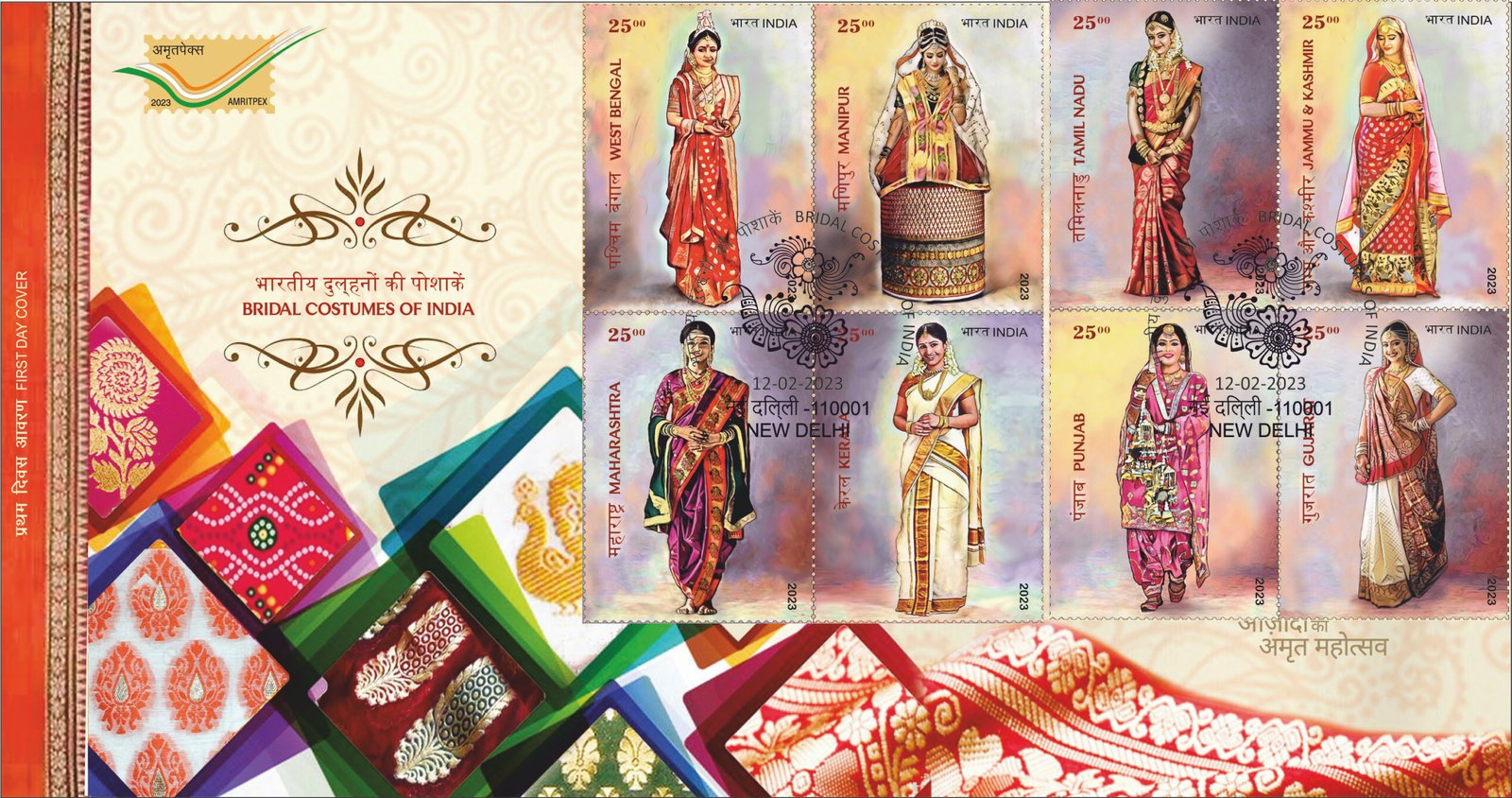Bridal Costumes of India

Technical Data
| Date of Issue | February 12, 2023 |
|---|---|
| Denomination | Rs. 100 |
| Quantity | 111,000 |
| Perforation | 14½ |
| Printer | Security Printing Press, Hyderabad |
| Printing Process | Wet Offset |
| Watermark | No Watermark |
| Colors | Multicolor |
| Credit (Designed By) | Ms. Gulistaan Ms. Nenu Gupta |
| Catalog Codes |
Yvert et Tellier IN BF225 Stanley Gibbons IN MS3842 Colnect codes IN 2023.02.12-03 Michel IN BL241 |
| Themes | Suits and Costumes |
Bridal Costumes of India – A Celebration on Stamps
Weddings and Indian Culture
Weddings in India are more than just ceremonies — they are a vibrant showcase of culture, rituals, food, clothing, and traditions that reflect the diversity of the nation. A wedding is considered a sacred union, where family, friends, and community come together to bless the bride and groom as they embark on their new journey.
The color red dominates Indian bridal attire, symbolizing new beginnings, prosperity, and feminine power. It is also associated with Goddess Durga, representing strength and transformation. Since marriage often brings greater change for the bride, her bold attire reflects her new life, commanding attention on her special day.
Bridal Costumes Across India
North India
The Bengali bride wears a Banarasi saree. Most Bengali brides prefer to wear a red Banarasi saree embellished with gold details or embroidery to match the gold jewellery. The traditional Bengali bridal look comprises of a beautiful red Banarasi saree, alta or red water colour on the hands and feet, mathapatti, necklaces, mukut and red and white bangles with gold.
Western India
The Marathi bride: during the wedding put on a beautiful yellow or green Paithani saree with a golden border, hair tied in a neat bun, decorated with pearl ornaments and Gajra. The Paithani saree can either be woven in Kanjeevaram silk or even Banarasi silk. Most Paithani sarees have peacock and mango motifs of the Pallu and a square block design on the border. Mundavalya is the red and white beaded string like an ornament that the bride and wears across their forehead during their wedding ceremony. Two beaded string also fall from the string on either side on the forehead. Kolhapuri Saaz is the mangalsutra of Marathi brides.
Southern India
The Malayali bride: wears a white saree with a golden border known as ‘kasavu saree’. The Kerala bride has started pairing her traditional white and gold saree with a shiny red silk blouse, layered gold jewellery and lots of flowers in her hair Her minimal jewelry and makeup, matching bangles and that oh-so-pretty Kamar Bandh are enough to make her look like a perfect Kerala bride.
Eastern and North-Eastern India
Manipuri bride: The outfit of a Manipuri bride is colorful and has a distinct style which is hard to find in any other community. A traditional Manipuri bride dons a skirt called Raslila on her wedding occasion. The Chakmas brides also wear black and red sarong which is also known as Pindhan in the local language. This entire outfit is teamed up with a blouse known as Silum. The Magh brides from the Manipuri community don the Thami sarong that covers almost the entire body and is coupled with a choli or a blouse which is full sleeved. The traditional outfit of a Manipuri bride is accessorized with the basic ornaments such as bangles, nose rings, necklaces and earrings.
Stamps Celebrating Bridal Costumes
The Department of Posts proudly celebrates this cultural richness through the issue of two sets of Souvenir Sheets with commemorative postage stamps on “Bridal Costumes of India.” These stamps showcase the diversity of Indian bridal attire, capturing the vibrant colors, unique traditions, and regional artistry that make Indian weddings unforgettable.
For philatelists, this collection is not just a tribute to the beauty of Indian weddings but also a reminder of how deeply woven traditions are into the fabric of society. Each stamp is a miniature canvas of India’s cultural heritage, honoring the spirit of unity in diversity.
First Day Cover

